Nicholas Drummond
For some time, the US Army’s Special Operations Command (USASOC) has been interested in intermediate calibres. Recognising the limitations of 5.56 mm ammunition, especially when fired from M4 Carbines with 14.5” barrels, it considered the .300 Blackout cartridge. This is very similar to the Russian 7.62×39 mm cartridge fired by the Kalashnikov assault rifle, but while it provides more consistent terminal effectiveness versus the standard M855 loading of 5.56 mm NATO, it did not increase engagement ranges. The wider re-adoption of 7.62 mm was not an ideal solution either, because of ammunition weight and recoil penalties. With much industry discussion of new calibres, USASOC believed it was worth investigating the potential benefits.
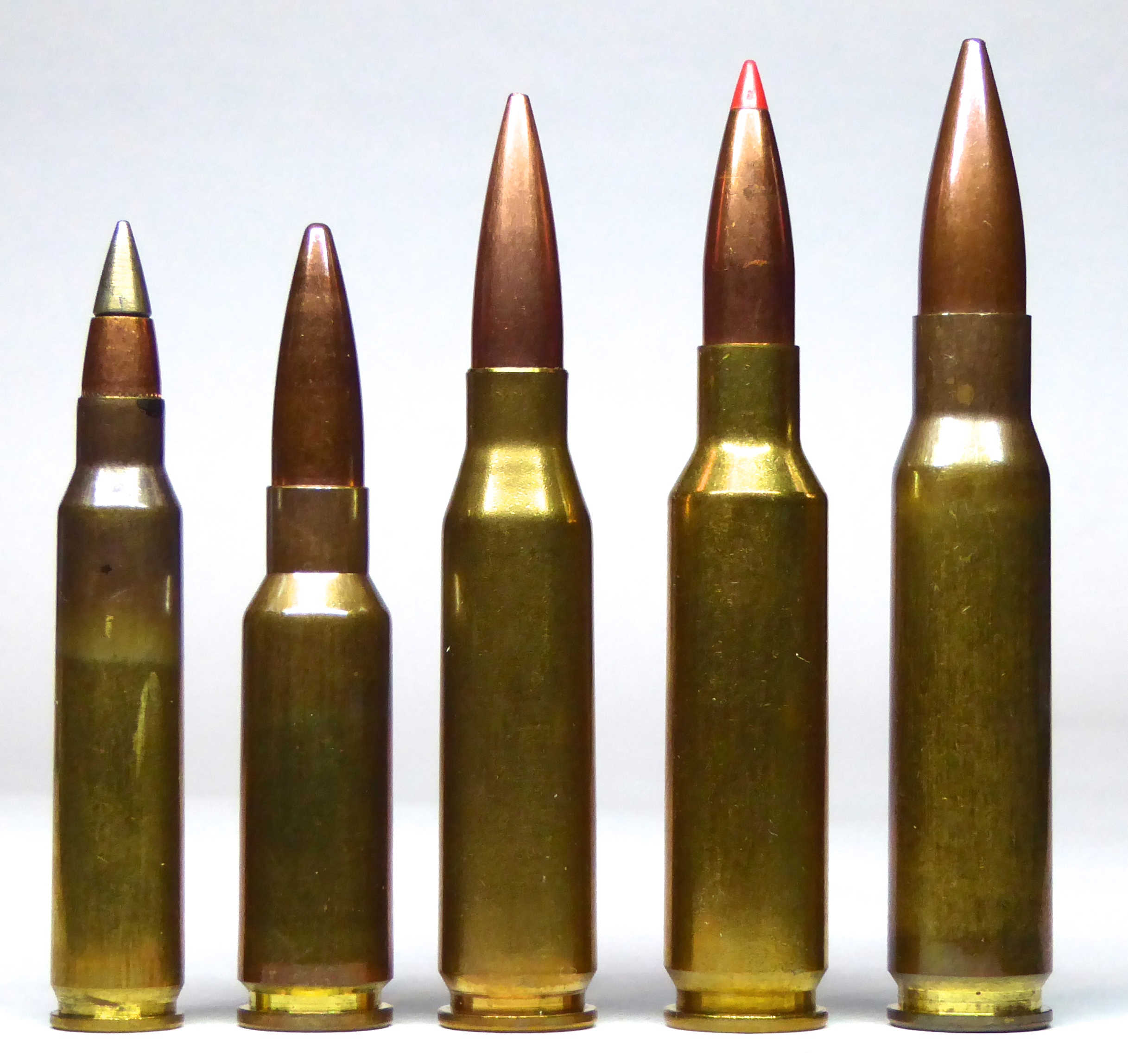
During 2017, USASOC conducted an evaluation of two intermediate caliber cartridges that could be adopted with only limited modifications to in-service 7.62 mm weapons. These were the 6.5 mm Creedmoor (CM) developed by Hornady and the .260 Remington. A comprehensive test programme included Doppler radar measurement to identify the best-best-performing projectiles, terminal effects evaluation, powder selection to ensure thermal stability, charge assessment, jump sensitivity, and other range testing to optimise the TDP. Four separate projectile weights were considered:
- 123 grains / 8.0 grams
- 130 grains / 8.4 grams (corresponds with current 7.62 mm M80A1 EPR)
- 140 grains / 9.0 grams
- 147 grains / 9.5 grams (corresponds with current 7.62 mm M80)
The final ammunition specification will be decided by the US Government before an RFQ is sent industry to manufacture production batches of the preferred ammunition type. Although no details have yet been made public, the US Army’s PM Soldier Weapons will have almost certainly supported this project with an EPR-style 6.5 mm bullet designed by RDECOM to allow the operational use of this calibre. We have already seen such a projectile developed for Textron’s 6.5 mm cased-telescoped ammunition system and it appears to have devastating potential.
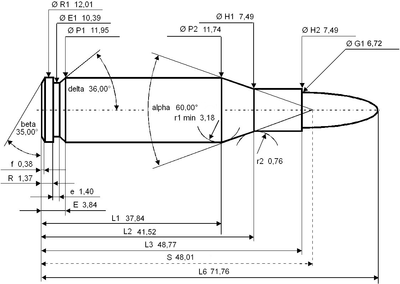
Weapon reliability testing was conducted using modified 6.5 mm rifles based on the two sniper support weapons currently in US service: the FN Herstal FN SCAR Heavy Mk 20 Mod 0 Sniper Support Rifle; and the Knight’s Armament KAC M110 Semi-Automatic Sniper System (SASS). The Heckler & Koch H&K M110A1 Compact Semi-Automatic Sniper System (CSASS), which will soon enter service, was also evaluated. Two weapons of each type were used, one in .260 Remington and the other in 6.5mm Creedmoor and fired in comparison to existing 7.62 mm versions of the same rifles.
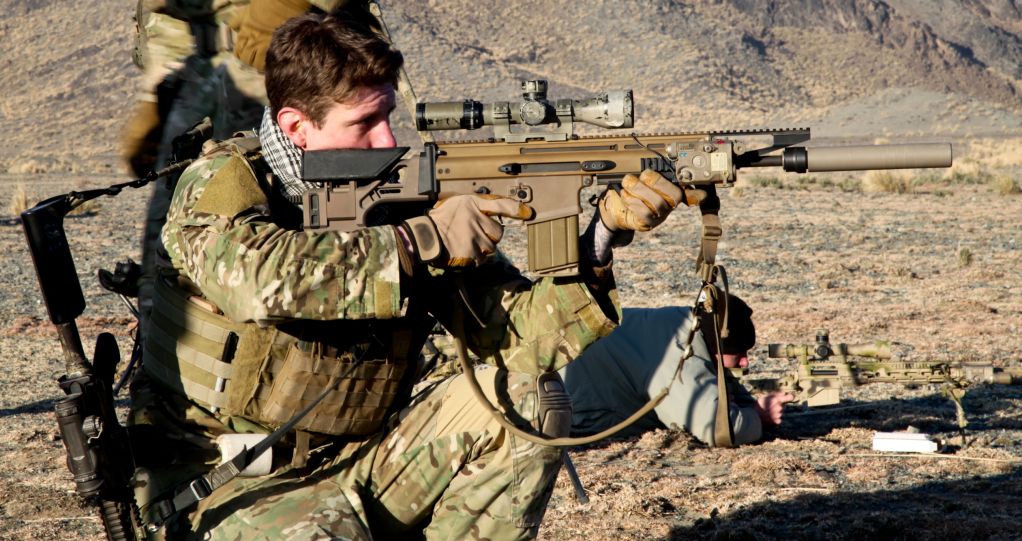
A third intermediate ammunition type could have additionally been tested, but wasn’t. This was the US Army Marksmanship Unit’s .264 USA cartridge. Instead of delivering a performance markedly superior to that of 7.62 mm, the US AMU round only matches it. Using extended 6.5 mm Grendel brass rather than a larger capacity case, the .264 USA lacks the extra long-range punch delivered by the more powerful rounds, but is usefully lighter.
USASOC’s test results showed that .260 Remington and 6.5 mm Creedmoor rounds comfortably outperformed the US Army’s existing 7.62 mm M118 sniper cartridge at long range (see table below).
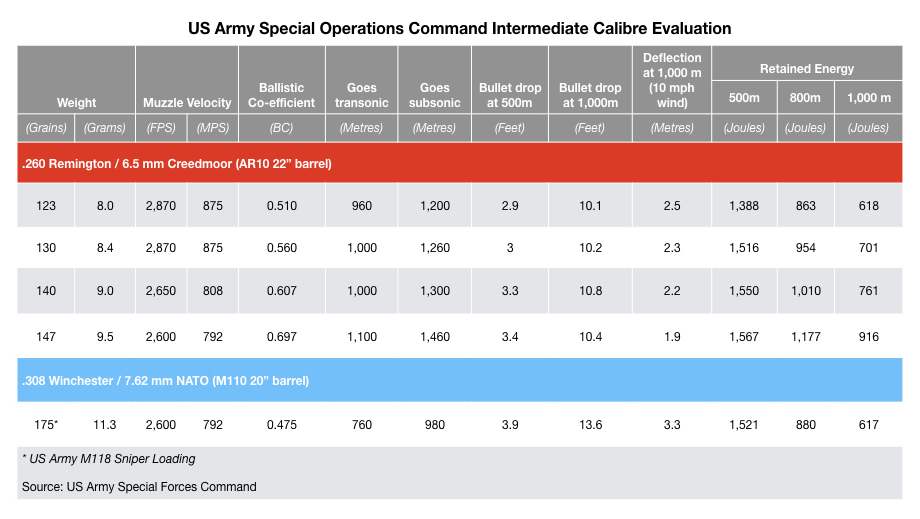
In May 2018, USASOC announced that its preferred choice was the 6.5 mm CM and that it would adopt a further-developed version of this round as a Precision Intermediate Caliber. Though similar to .260 Remington, the 6.5 mm CM cartridge delivers comparable performance with lower recoil. It was also felt that the cartridge had a better growth path to accommodate potential future loadings. Versus legacy 7.62 mm ammunition, 6.5 mm CM ammunition was found to double hit probability at 1,000 metres; to provide a 33% increase in effective range; to deliver 30% increased energy on target; and decrease wind deflection by 40%. The other advantage of 6.5 mm CM is that it uses a necked-down version of the current 7.62 mm cartridge. This means it can be adopted in legacy 7.62 mm weapons with just a barrel change.
Anecdotal feedback about 6.5 mm CM performance has been overwhelmingly positive. Former-US Army paratrooper, Jim Schatz,* an architect of this initiative, advisor to SOCOM, and longtime advocate of intermediate calibres, described 6.5 mm CM as “a laser beam that was boringly accurate.” Industry insiders who have used this calibre confirm that its greater aerodynamic efficiency and superior ballistics correct everything that was ever wrong with 7.62 mm ammunition.
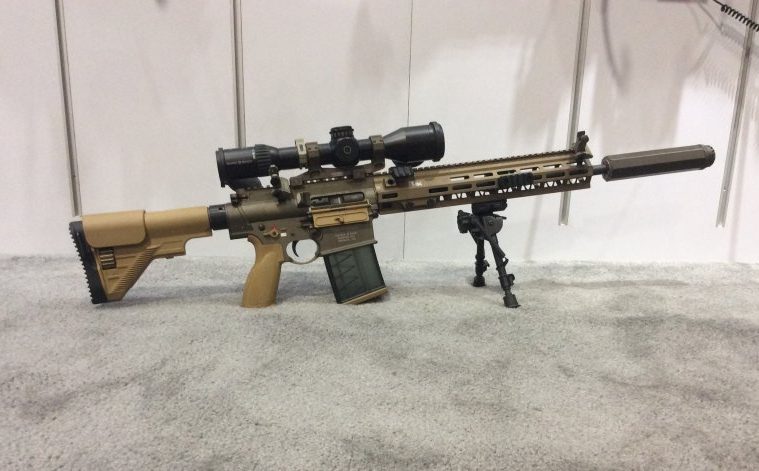
Earlier this year, it was also announced that USASOC would not only roll-out 6.5 mm CM in a long-range precision rifle, but would also use it in a carbine and assault machine gun. Unofficially, this suggests that the tests have exceeded expectations and that US Army Special Forces now intend to field their own new calibre long before the rest of the US Army and NATO does.
It can only be hoped that the British Army’s Infantry Trials & Development Unit (ITDU) will see fit to conduct its own intermediate calibre trial. It would take little to persuade LMT or Heckler & Koch to provide 6.5 mm CM versions of the L129A1 Sharpshooter rifle or HK417 / G28 DMR. Similarly, FN Herstal or Heckler & Koch would also supply a modified L7A2 GPMG or MG5 (HK121) machine guns, also in 6.5 mm CM. Perhaps UK Special Forces will also evaluate it?
It would be helpful if BAE Systems at Radway Green produced a 6.5 mm projectile along the same lines as those it developed for its excellent 5.56 mm and 7.62 mm EP enhanced performance rounds. This is because, so far, no European army has adopted US EPR projectiles due to concerns about whether they are compliant with the Laws of Armed Conflict. EPR bullets have an exposed steel tip for improved penetration and jacket is designed to rupture so that the bullet will fragment for improved lethality. Projectiles that fragment or deform are prohibited.
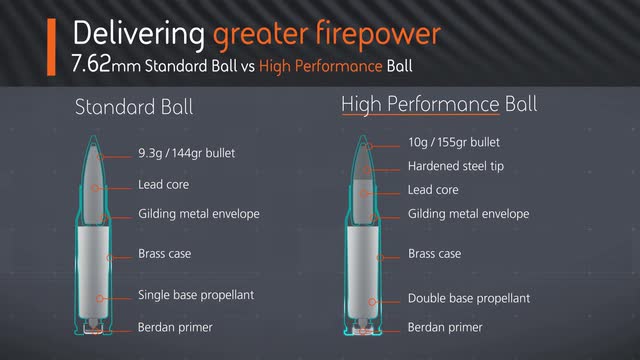
The importance of USASOC adopting 6.5 mm Creedmoor ammunition cannot be overestimated. First, it is a low-risk, low-cost approach to intermediate calibre validation. With the parent case based on a 7.62 mm cartridge, it is easy to implement and test versus legacy small arms systems. Second, it will provide a wealth of robust data including lethality and barrier penetration comparisons versus current NATO ammunition. It will provide an understanding of the logistical implications of adopting such a calibre, and an indication of whether a single intermediate round can replace both legacy 5.56 mm and 7.62 mm cartridges at section- and platoon-level. Third, it will allow polymer or alloy versions of standard brass cartridges to developed and tested. These offer a weight saving of 25-30% versus brass, with a starting weight of 20-22 grams for a brass 6.5 mm Creedmoor round, depending on the loading, final cartridge weight could be as little as 15-16 grams, which is only marginally heavier than 5.56 mm. Fourth, the US Army’s Next Generation Squad Weapons (NGSW) Program is extremely ambitious. Some would say that the requirements are unrealistic, if not unachievable. The 6.8 mm ammunition around which future weapons are to be designed are likely to generate much higher chamber pressures “to ensure that the rounds can still blast through enhanced enemy body armor at up to 600 metres.” Such performance is expected to be achieved by using pressures similar to those of a tank gun, i.e. up to 550 MPa (80,000 psi), instead of usual 5.56 mm pressures of 380 MPa (55,000 psi) for the M855 and 420 MPa (60,000 psi) for the M855A1. Based on current interpretations of the NGSW requirement, the US Army is looking for a weapon that’s considerably more powerful than 7.62 mm, with much greater recoil. While Textron’s Cased-Telescoped Small Arms System (CTSAS) looks promising, should it fail due to technical issues, due to cost, or for any other reason, then USASOC’s 6.5 mm PIC would provide a useful fallback capability, just as 5.56 mm did when the US Army’s SPIW project ran into technical difficulties in the early 1960s. Finally, 6.5 mm Creedmoor ammunition and weapons are likely to inform the NGSW effort by providing a useful technical benchmark for comparative evaluation.
There are a number of small arms professionals who believe that all efforts to develop a new intermediate calibre to replace 5.56 mm and 7.62 mm are futile. Their fundamental argument is that contemporary infantry rarely need to shoot beyond 300 metres. When they do, other more suitable support weapons are available, such as the 40 mm high velocity Automatic Grenade Launcher or 12.7 mm Heavy Machine Gun. Moreover, the number of occasions when 600-metre firefights take place, let alone 1,000-metre engagements, are likely to be few and far between. They also argue that if a 600-metre range requirement genuinely exists, then 5.56 mm ammunition could easily be developed further to achieve the required performance.
While the above points certainly merit consideration, those who advocate intermediate calibres would respond that the number of instances when a 600 to 1,000-metre range is needed is actually much greater than realised, because much of the previous analysis of combat engagements ignored the role of small arms in long-range suppression. While dismounted infantry units will usually have ready access to long-range support weapons, sometimes patrols will be isolated or surprised. When this happens, having the extra range capability that a more powerful organic weapon and ammunition type confer can be crucial.
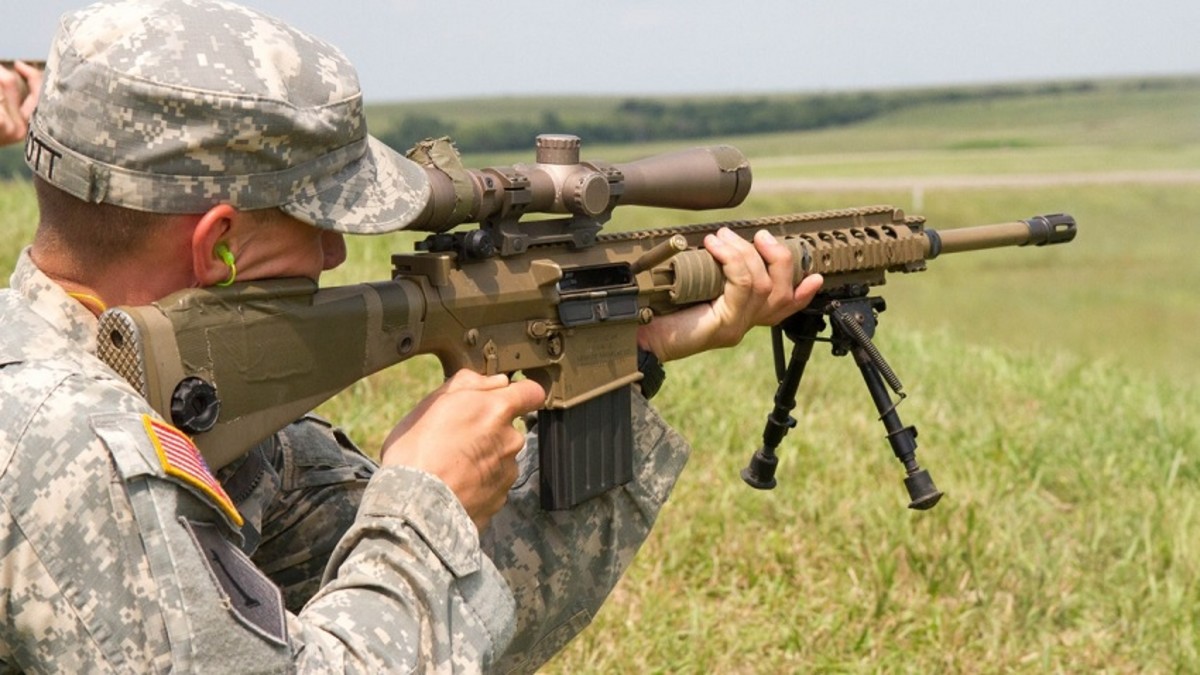
The other important point to make is that any further development of 5.56 mm NATO ammunition is likely to require a longer cartridge with an increased capacity to give it more range and to contain a longer, more aerodynamic projectile. Thus a new 5.56 mm round is likely to be longer and heavier and require a new weapon with a longer action length. While this could be offset by the use of lightweight 5.56 mm cartridges, a polymer version of the 6.5 mm Creedmoor round would be so close to the weight of legacy brass 5.56 mm ammunition that the range and terminal effect gains make the marginal weight increase worthwhile. In particular, using 6.5 mm Creedmoor in a light machine gun instead of 7.62 mm would reduce the overall section/ squad weight burden as linked ammunition carried by every member carries a belt of 50-100 rounds.
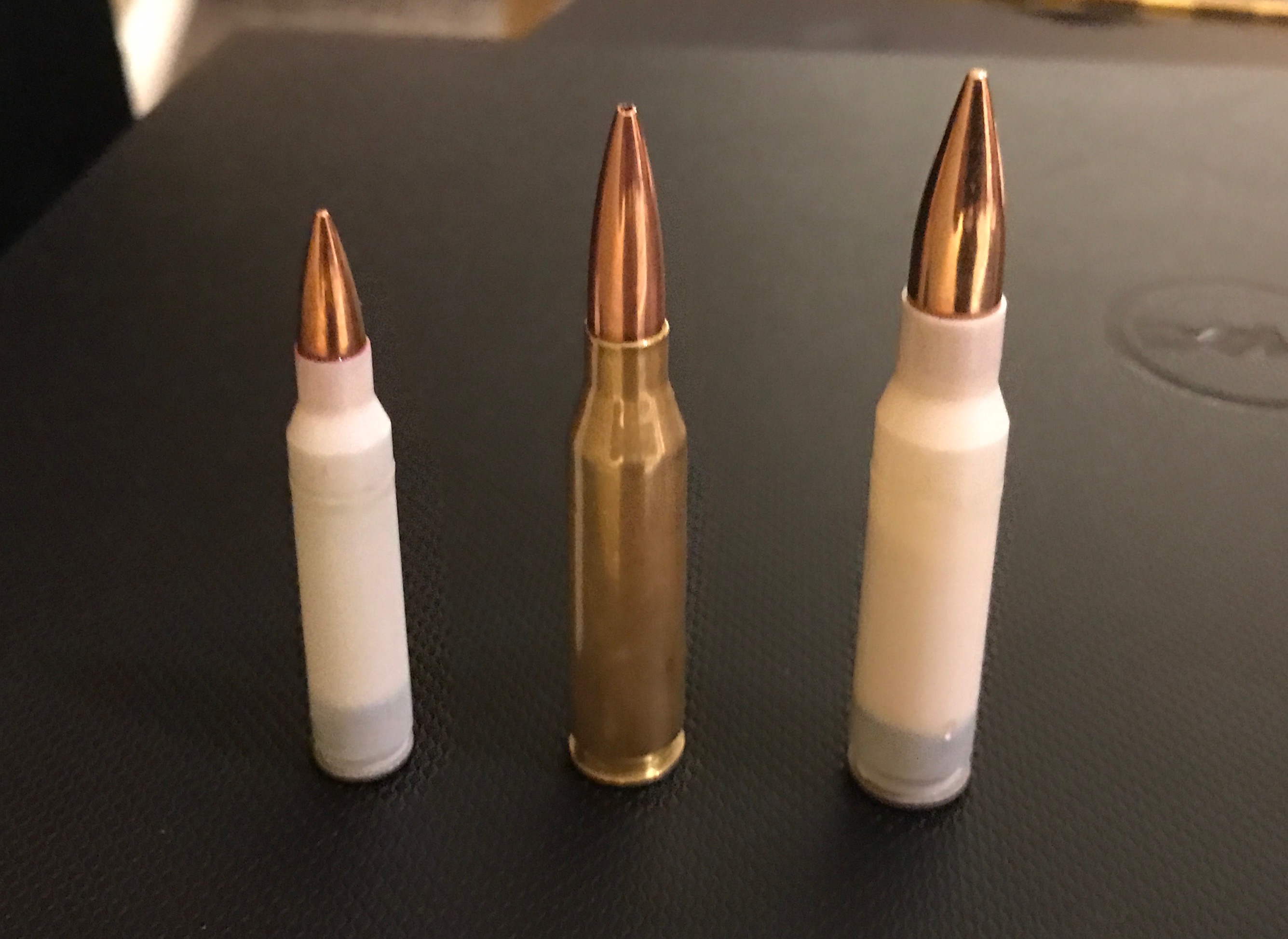
Many of the arguments for and against an intermediate calibre are hypothetical. They need to be tested, which is exactly what USASOC’s 6.5 mm Precision Intermediate Cartridge will allow to happen. With hard evidence, NATO armies will be able to make robust future weapon and ammunition choices.
*(The late Jim Schatz was also a close personal friend and his loss last year was much mourned by the small arms community.)

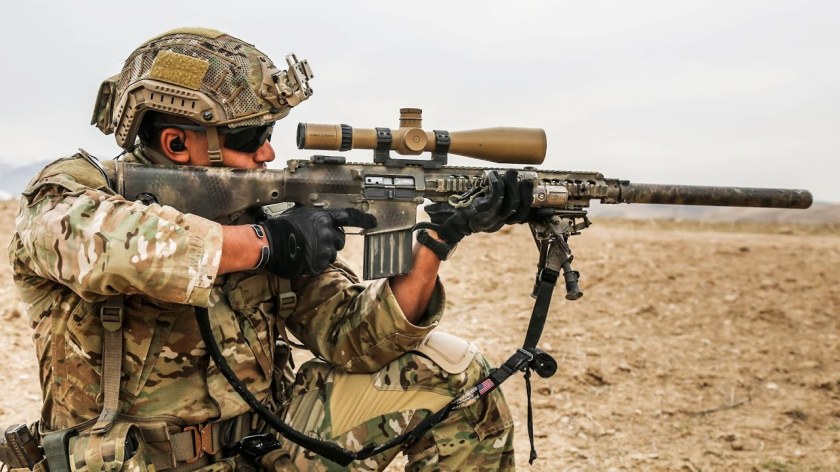
How well does 6.5 Creedmoor penetrate body armor compared to 7.62 NATO? The bullets have a higher sectional density, but lower energy (at shorter ranges). Would be interesting to know.
LikeLike
Why not, if it only takes a barrel change?
“Unofficially, this suggests that the tests have exceeded expectations and that US Army Special Forces now intend to field their own new calibre long before the rest of the US Army and NATO does.”
And then you proceed to give a dozen (other) good reasons. The biggest one for proceeding with this – that I can see – is not only the risk, but the time that the army project will take.
LikeLike
just as well the replacement for the SA80 is a while away yet.
LikeLike
I wonder if SOCOM has considered necking-out the Creedmoor case to 6.8 mm in order to take the EPR military bullet specified for the Next Generation Squad Weapons (see separate blog post)? This would make sense as there are currently no military 6.5 mm bullets in production, only hunting or target rounds, and the big steel penetrator of the EPR should provide very good penetration. It would also mean that the SOCOM weapons and ammunition could act as a conventional backup in case the Cased Telescoped systems don’t make the grade.
LikeLike
As a fmr American (meaning my opinion’s not well informed already…lol) and as an SME/someone who tried to learn all they can on something like this as it will always be an urgent matter as long as powder is being used on Earth? lol..jk….I found the 6.5 CM as the NOT preferable choice. I do NOT care if it could pierce the hide of any IBA (body armor) at ANY distance…We had these surprisingly not cumbersome, customized by fmr Bragg armorers for ONLY one Unit and one Unit only…And they took the infamous 7.62 DMR style SR-25 (this was in that 2006 thru 2009 time periood, so we’d essentially jerry rigged ourselves a “battle carbine” or what KAC calls now their line of SR-25K EC2 ACCs? I think?)….We had ISRs made by the greatest designer outside of those demonically brilliant weirdos at HK…KAC didn’t get the CSASS, but had it? or LMT? It would’ve (and COULD HAVE) been better. ALL are modular if we MUST HAVE this Creedmoor crap…Thought the Grendel? The 7.62 NATO? THOSE ALL did the same thing…SAME EXACT thing as the Creedmoor. You can show me charts all day long….
…Sorry we’re stubborn American snobs, but I AM 110% correct to say that the Brits were THE MOST ahead of the times by taking on the LMT MWS as their DMR….That 7.62 NATO lightweight (yet DURABLE BEAST) was what we later had in our KAC carbine-sized thumpers or SR-25 “Peaceweepers” as one of the armorers randomly named them….14.5″ heavy barrel but that was as heavy as it got. TOTALLY MODULAR like the Brits’ LMT L129A1 or whatever the MWS was called…and as contracting personnel who had DoJ/DoD contracts, we got to try new things invovling DARPA related gear…We tried an SR-15 (not the bigger 25 in 7.62 NATO as we were trying to make ourselves a version of this 6.8mm solution they got now!…We took a 5.56mm Barrett Rec7 in 12-12.5″, then a integrally suppressed KACs in 6.5 Grendel…THEY BOTH changed the game but due to NDAs back then (same as breaking a legally binding DoD agreement…on classified and/or TS/SCI level? BUT SERIOUSLY A BAD IDEA…now look!! Sig? Great designer of ARs, ammo etc…so is HK…but caseless? Ehhh….and so far, giving FN USA at least TWO chances at contributing is the ONLY was this could be saved….I know guys from those same aforementioned units WHO TESTED THAT FAILURE OF A AN UNWIELDY, AESTHETICALLY HALF COOL AND FUNCTIONALLY (well that’s obvious now right?) MCX!!!! These Delta operators helped design certain parts alongside their ARDEC counterparts….THEN? Then, as the first ones, just like the P320, we saw issues. First off, you don’t make 5.56 and 300BLK the ONLY CALIBER VARIANTS if you want to advance this next-gen Army warfighter gig…but BAH! too much..I’m out, and I know nothing about firearms, deplore violence…(against me) and honestly????????? If that 6.8 is a diff metallic type of case (I heard that’s what they’re doing now, so the weight still super light, just as reliable, AND it may work so well NATO buyers may be open to hear the pitch about changing ENTIRE STOCKPILES lol….HOWEVER, if not, as the articles say…NO, I do not agree about the CM but??? This newest version of the Valkyrie (there’s several I’ve tried) I really think it screams….THEN, the .264 USA? OF COURSE we should…but that’s a stretch of an order…OR we just do what my teammates did. Take Wilson Combat .300 HAM’R (NOOOOOOO not the 458 SOCOM/HAM’R giants that were like .50 cals in a mag) I mean these were 130gr big boys, 25 rnds in a 5.56mm mag, just needing like one change (I forgot what but not hard nor as many as ANY OF THE OTHERS!!) and then there’s the Grendel??? BOTH, well…just watch gel block videos of the 130gr “Controlled Chaos” tactical round version of this hog hunter (the 300 HAM’R) thats got the flight of a Creedmoor I’m sure, but to sat A F#$K lot more bang for your buck?? haha….watch when it hits ANYTHING. You could wear an oven taped to your front…yer done…
The latter? We all know how pure bad ass, straight up metal this brutal, ruthlessly psychotically fun to shoot round is…THE 6.5 GRENDEL SHOULD HAVE BEEN OUR PRIMARY CHOICE IF WE’RE TOUCHING 6MM OR 6.5s EVER FOR THE SOCOM CROWD OR ANYONE ELSE….I GOT A WHOLE GROUP OF PRETTY HARD MOTHERF@%r$ WHO WILL ABSOLUTELY TELL YOU THAT IS CORRECT. TO STOP BEING LAZY, US ARMY/OR VOGEL/OR SOCOM OR WHOEVER IS BEING STUPID THAT’S THE LAST RUNG IN THIS…AGAIN…I’m no vet, I’ve been shot at, and done the same back and hated it every time…IT WAS NOT IN OUR KNOWN WARS LIKE OIF etc…Not even overseas. It was south of us. ….and as I am telling you, ask around. Would the Grendel wreck Putin’s poop pushers or no??? Just saying….as being a former IC (fmr tactical solely in posture, but a PSD “trunk monkey” in mounted security roles, plus I just started writing, I had been touring in one of those crappy hardcore meets metal chug-chug bands for a while, then total rip off of like Coldplay bu heavier verison w/Deftones heavy leads etc when they showed up home from places you don’t think we’re sending SOF to…NOT AFRICA either…Think E. Europe. Anyways, I was over it….And being bilingual and growing up w/graduates from Bragg who became top tier dudes wasn’t bad lol. As I said, as an SME, studying Asymmetrical Warfare in Non-Permissive Environments or? well: “Defeating Grey Zone Full Spectrum Threat Networks Using Their Own Weight Against Them.” That was my last piece I wrote that wasn’t an Ebook. I think the guys helping me w/it would say Creedmoor can EAT MORE….giant weener. Same w/300BLK…It’s fine for ninja mode as these stupid younger MARSOC guys say (I’m 36) but it’s crap by most accounts and the 300 HAM’R WRECKS IT…just not suppressed …that’s it. Take a .45 ACP into those AR pistol deals they got now…bam….same thing as 300BLK minus some range.
Anyways, that’s my 30 pages of angry two cents
LikeLike
I don’t claim, especially as a civilian SME who was just lucky to be bilingual & somewhat trained in a tactically fwd leaning series of LE courses in order to basically be a trunk monkeying ‘terp (as a brief part of a fmr IC in priv sec w/ the firm itself being under an offshoot of TITAN-L3 Comm in S. California) that worked contracts to do PSD for Mexican municipal officials during the middle of the last half of Iraqi Freedom, and was w/actually a surprisingly diverse mix of fmr SOF (from US top tier units, FBI HRT fellas etc, to South African, Kiwi, and numerous fmr Mex FES etc) all w/ an unknown “ joint interagency groups” or aka JIATFs (joint interagency task forces)… I say this because we had near daily DFEs that really educated me on SOOOO many of our (and other) military-preferred systems & cartridge combinations (in these HIGHLY random yet consistent engagements & short, vicious quasi planned ambush type hits done on our SUV caravans led by Baja LEO & Mex Marines) and almost always were not just by Los Zetas “new initiates” lol.. (mainly kids from local Baja neighborhoods that had enjoyed pretending they were gangsters)-but also what DTOs (drug trafficking orgs/“cartels”) tried outsourcing the efforts to! There were Guatemalan Kaibiles (very well trained SOF who just didn’t know our lead vehicles had longtime JSOC “old salts” in the front and would find themselves getting smokechecked very, very rapidly) but the Venezuelans that came up in small adviser teams (usually fmr DGICM proxy types..that’s their Defense Intelligence agencies) ALWAYS had body armor…sorry to do a long segue but, anyway, we found out that long before it was common knowledge around LE circles and the Ft Bragg ARSOF community? We saw even our firm’s DPMS 14.5” .223/5.56 platforms underperform with sometimes even the feral 77gr Black Hills “go to” round by most in the tactical world apparently (I certainly was not complaining as our fmr NSW frogs said they were a treasure for conventional units that only SOF got first dibs on) so I stuck with it on my personal custom DPMS Panther 16” that had a great SureFire short can & weighed less than any of the carbines I had used before (I used only one better combo, a brief time I was allowed to have our TL’s older gen Knights Arm7.62 in this ridiculous setup that must’ve been a $4000 rig! It was my first time seeing a Unit guy who had taken a KAC SR-25 but cut to the style u see today w/ACC or A5-“K” style 14.7” highly maneuverable “battle carbine” (for Delta armorers, I should have seen these now standard KAC shorter 7.62s arriving today) etc & ohhhh, and had let’s say the Barrett Rec 10 been available? Yep..AND outside of the obviously smart move on the UK military’s part by having the LMT MWS in all the great customizable configurations, the new LMT “Sharshooter” and the compact Rec 10 would have been just SUCH better choices for the CSASS program as opposed to YET ANOTHER iteration of the HK417A5!
I digress..what I found in the very few times I was personally putting anything downrange in real world fights? (Few=less than ten…trunk monkeys don’t get a very long sight picture on passing rooftops lmao) I had a guy take my DPMS and played around with two uppers w/very durable optics options..the newest 6.5 Grendel—not the Creedmoor that’s gonna require most to traipse around with unwieldy 20” barrels to get all that bad assery up to the standards set by the rounds hype crowds! My Grendel upper was an even 14.5” (like my .223) and was tweaked (including suppressor) to be 16.5” and not even remotely heavy or high on recoil! And those Bolivar buttplugs dropped whether or not they had their plates in…the reason is that I only chose the caliber because all our ODA guys-and not just green berets, but RRC, as well as fmr Green guys that we were honored we had as mentors on said matters-AND ALL were hog hunters! So screw trying to muscle in more 300BLK setups w/the 416A5s etc/or BCMs and DanielsDef ARs (I can tell you they’re using those Geiselle URG-I rigs last time I asked obviously) but, strangely they didn’t mind the in-betweens as many JSOC & UKSF fellas liked Troy SOC-Cs, PWS, and a few Wilson Combat guys too, but all aforementioned ARs are outdoing the Sig MCX II (despite its modular awesomeness, familiarity for the real warfighters today matters imho FAR more) especially the originals in all the flavors of new 5.56 cartridges & .260 style upgrades on fmr favorites for thumping… like the never failing KAC SR-16s our forces should all have, or those newest LMT CSWs the DevGru fellas LOVE using far more than an MP7–hence my closing argument…if you were not getting any really distinguishable advantages to the HK’s undisputed line of great gunfighters’ guns from the HK45 up to the first 416/17 (but monopolizing in how it flooded our DoD orgs, heavy in weight for those who have range time with the M27 IAR? No wonder once I saw the CSASS finalist I was just 🙄) ..so, I say UK! You’re just very lucky to have had the LMT lines among the others because that company is like Aero, DD, or Knights OR if you heard about that 300 HAM’R carbine that outshoots just about everything I seen? If not try it, but please call our pentagon and tell em we don’t even need a new 6.8mm AR or 6.5CM unless magically they cut down the length to something doable. (PS…really, I could refer anyone to dozens of retired SOF who say they WISH they could have had a Wilson Combat “ranch gun-style” Ranger series carbine in 14” w/the folding stock (I think) & regardless of most aren’t subsonic, they made great pencil-style lightweight-when-loaded whole kits, even though it is meant for hogs if you get a minute w/one who’s mag has in it the newest HAM’R 125gr Controlled Chaos round that breezes past everything out there from the Valkyrie to any special custom competitions loads!
LikeLike